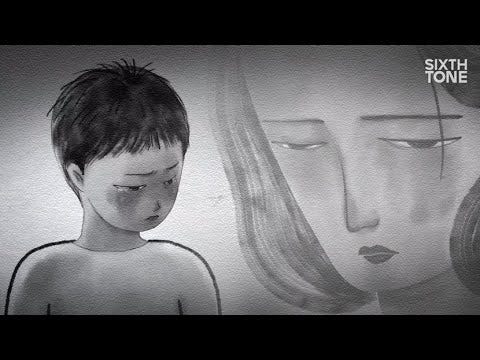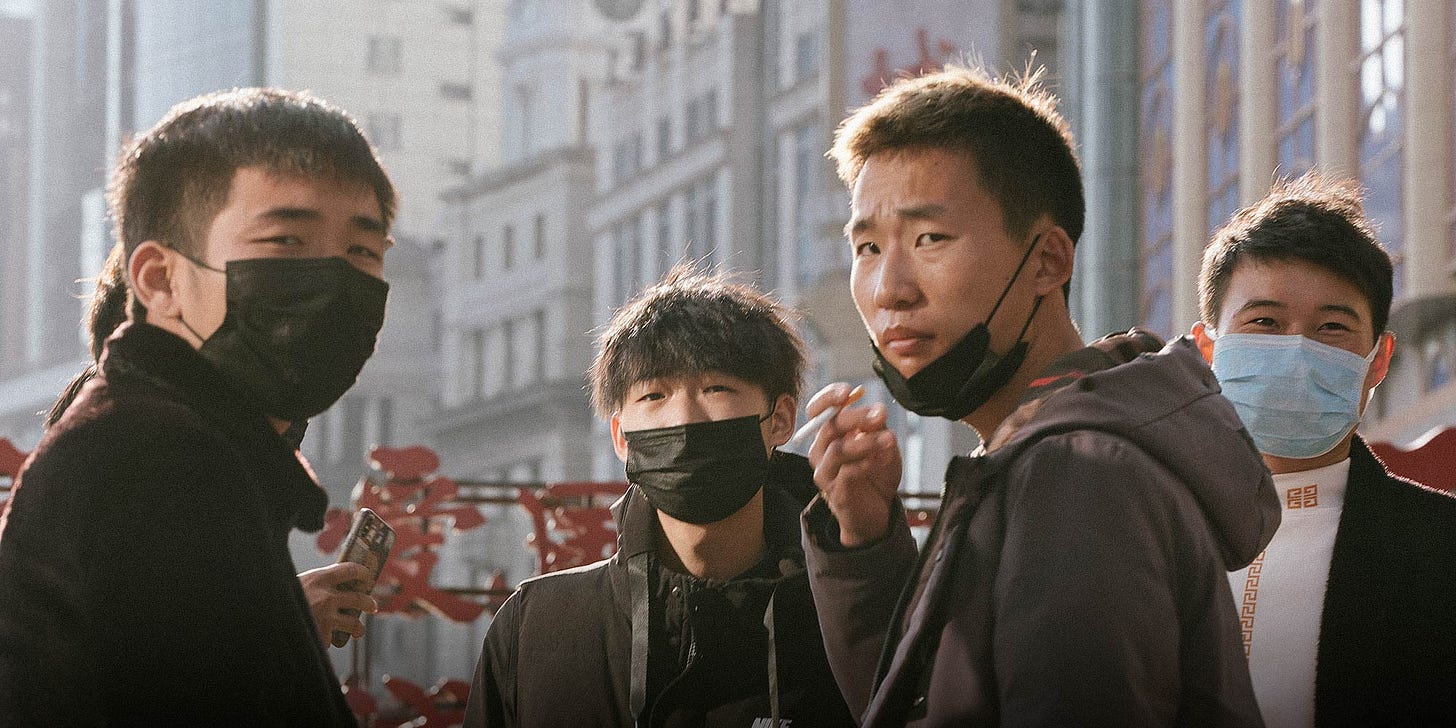Issue #2: Love from chaos + Sand frontline + Jersey City square dancing, and more
A family coping with autism, desertification in Inner Mongolia, and a unique take on the Chinese American identity through photography and video.
Hi there,
Happy Dragon Boat Festival! It’s Yan, Beimeng, and Charlotte here. This is the second newsletter of Far & Near, a collection of the best visual stories coming (mostly) out of China. Thank you so much to everyone who signed up. If you like this newsletter, please consider becoming a paid subscriber and telling your friends about it.
Our top picks in this issue: a beautiful animation about a mother’s journey of learning to accept her son’s autism, an overlooked Asian migrant community in the U.S., and a rare, three-part act of enterprise journalism tracing China’s sand frontline.
And a little preview of our paid issue next month: we’ll be releasing a Q&A with Will Wu, a director who has been working for two eminent short documentary platforms in China: he was part of the founding team at Arrow Factory and is now at Figure. Will’s best-known films include a profile about MC Tianyou, the “King of Hanmai,” and a story about a mafia boss turned embalmer. We’ll be talking about his filmmaking process, how Arrow Factory and Figure produce stories, and the state of web-based documentary videos in China.
Become a paid subscriber today to receive the next issue. Thank you again for your support!
Love from Chaos
When 3-year-old Yueyue was diagnosed with moderate to severe autism, his mother felt helpless. Like all mothers, she tried to give Yueyue the best childhood she could, but it turned out to be a steep learning curve as he seemed to live in a world of his own.
This short animated documentary, directed by Yuan Li and Hui Long, is a powerful piece about a mother’s journey of raising a child with autism. While the mother’s monologue does the heavy lifting of the storytelling, the black-and-white animation provides a strong sense of the emotional struggles the mother and son went through. The abstract graphic elements, such as shaking lines, prolonged shadows, and a screen full of scrutinizing eyes, effectively communicate the inner world of loss, loneliness, and anxiety. Towards the end of the video, we were moved to tears when Yueyue said ‘I love you’ to his mother for the first time when he was 13. We knew straight away that this was a must-include piece.
The mother’s experience is a typical one for families coping with autism, yet we rarely hear stories like this told in such an intimate way. We’re glad to see that the reporters and editors at Sixth Tone/The Paper could facilitate the collaboration between their subject and the animator to give this deeply personal story a platform.
Life Along China’s Sand Frontline
In March, the worst sandstorm in a decade engulfed Beijing and most of northern China, causing widespread disruption to daily life. On social media, people compared the apocalyptic scenes to those from the movie “Mad Max”. The sandstorm is said to have originated in Mongolia, where climate change and industrialization have accelerated environmental degradation. In China, Caixin sent three photographers to Inner Mongolia—the country’s first barrier for preventing sandstorms—whose inhabitants bear most of the burden of stopping desertification.
In western Inner Mongolia, photographer Yingfei Liang follows railroad workers whose task is to protect the tracks of the Linhai-Ceke Railway, which cuts through three deserts. Photographer Yingli Cai meets an environmental refugee who escaped the desertification of his native province Gansu more than 30 years ago, only to see things worsening and follow a similar pattern. In eastern Inner Mongolia, a young sheep-herding couple tells photographer Gang Ding how they are adapting to the drought that’s haunted the region.
We are highlighting this series both because of the quality of the images as well as the importance of the topic, although we feel that Caixin could have provided more resources to the photojournalists who had to take the images, report, and write the text for such a large-scale story. The series is worth sharing because, quite frankly, it’s difficult to find critical reportage on this scale in China these days.
PART ONE | PART TWO | PART THREE
Chinese Square Dancing Meets Manhattan
“Chinese American” is a fluid identity. There are those whose roots in the country were established during the California Gold Rush, and those who stayed after recently obtaining an American university degree. When can someone put their foot down and claim that they belong?
When we were selecting the story to celebrate AAPI Heritage Month last month, we wanted to choose a story that reflects our perspective as Chinese women who have lived in the U.S. So we revisited this documentary that follows a small group of Chinese “square dancers” in Jersey City, N.J., some of whom show up twice a day to practice against the backdrop of the Manhattan skyline. The squad is mostly made up of Chinese seniors who regularly commute from China to the U.S., where their children are fostering new lives and sometimes new families. But across the ocean back home is where these seniors have their social network, native languages, and the life they built for themselves.
To combat boredom and loneliness, they brought public square dancing—a popular way for Chinese retirees to entertain and socialize—to the U.S. The documentary’s director, Siyi Chen, is originally from China and happened upon this story on a summer evening walk. It is a story destined to be overlooked by American media, yet out of reach for most Chinese media. Chen’s care for the inner world of the people who could have been her own parents, or our parents, speaks deeply to us.
What else we’re seeing:
Pinglang Zhou’s street photography is full of humor and sharp observation. For this project, he roamed the remote corners of the Shanghai subway lines, which is the world's biggest metro system by route length. This expansive work also calls for an innovative edit and layout. For a better viewing experience, visit the link on your phone. Read the intro in English here.
Drawing from her own experience, artist Weijue Wang uses needlepoint felting to create wooly sculptures in the shape of female body parts. They represent the violence women suffer by undergoing plastic surgery in the hope of satisfying societal beauty standards.
In post-pandemic Wuhan, director Yijun Zhou follows a professional organizer as she helps three families sort through their deceased loved ones’ possessions. The process allows them to grieve, remember and move forward.
What we noticed:
WeChat-based publication “Aotu Doc”, an increasingly important voice on all things Chinese independent documentary, recently launched its own podcast “All to One Doc” amid a booming podcast scene in China. Check it out on Apple Podcasts, Xiaoyuzhou, or your favorite Chinese audio platform.
Chinese Independent Cinema Observer is a new bi-lingual journal based in the U.K. dedicated to the study of Chinese independent films and film culture. The editorial team is made up of some of the most important names in practice and academia who are experts on the Chinese indie film scene.
Who we are:
Yan Cong is a Beijing-based freelance photographer and documentary film producer. She sometimes writes about internet culture for Chaoyang Trap.
Beimeng Fu is a video journalist based between Beijing and Shanghai. She is a lover of language and documentary.
Ye Charlotte Ming is a journalist and photo editor covering stories about culture, history, and identity. She’s based in Berlin.
Writers: Beimeng Fu, Ye Charlotte Ming, and Yan Cong; Copy editor: Sarah Magill
Have a comment or just want to say hello? Drop us a line at yuanjinpj@gmail.com
Liked our content? Become a paid subscriber of Far & Near and forward it to a friend!






